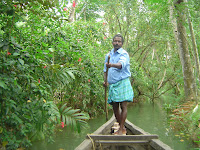Today I sit on a train facing backwards.
Every once in awhile I must resist the urge
to turn my neck to discover what lies ahead.
The climbing rocks of the Western Ghats,
the fluorescent green leaves of rice patties,
the man riding his bike on a narrow dirt path
with no village in sight for kilometers,
the dancing field of sunflowers,
the lush coconut fields,
the rising tree with no green leaves
but gorgeous flowers like orchids
gracefully resting on each of its dainty branches,
the cow with its rope tied through its nose
exchanging glances with me,
the sporadic Hindu temple
claiming ownership of a rocky pyramid shaped hill.
All these things I see contentedly looking backwards
resting my eyes on what has already past.
























